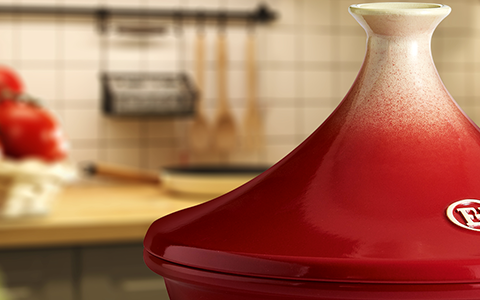Tajine – The Pot of 1001 Aromas
The beauty of a tajine lies not only in its looks, but in its versatility—you cook in it, and you serve from it. The name refers both to the North African earthenware pot and to the rich, slow-cooked stew it creates: a dish full of spices, meat, and vegetables that dreams are made of.
A Legacy from the Land of 1001 Nights
The tajine is far from a modern culinary gadget. This distinctive conical clay pot dates back over 1300 years and is thought to have been used by nomadic tribes as a portable oven. Its design, both simple and ingenious, keeps steam trapped inside during cooking, ensuring tender meat and deeply infused flavors.
How the Tajine Works Its Magic
The wide base of the pot holds ingredients, while the conical lid helps condensation drip back into the stew. As the dish simmers slowly over heat, it bastes itself continuously, keeping everything moist, flavorful, and incredibly tender.
Pro Tip: Because it cooks low and slow, even tougher cuts of meat become melt-in-your-mouth delicious in a tajine.
A Shared Culinary Experience
Traditionally, tajine is enjoyed communally—served straight from the pot and eaten with bread by everyone around the table. It symbolizes togetherness and the joy of sharing food, an experience as satisfying as the dish itself.
Form Meets Function
While many tajine pots are now created as decorative pieces, only some are actually suitable for cooking. If you’re buying one for practical use, be sure it’s heat-resistant and functional—not just beautifully painted. Ceramic tajines can often combine elegance and utility, making them ideal for both cooking and serving.
Around the World in a Tajine
Though rooted in North Africa, the tajine has crossed borders and inspired recipes around the globe, adapting to local ingredients and spices:
- Morocco: A classic Moroccan tajine blends lamb or chicken with carrots, onions, potatoes, dried apricots or prunes, and spices like turmeric, cumin, cinnamon, and coriander.
- France: French versions lean on herbs like thyme, rosemary, and oregano. A slow-cooked lamb tajine with garlic and Provencal herbs is a comforting festive dish.
- Spain: Smoked paprika, saffron, onions, and seafood can transform the tajine into a paella-inspired stew bursting with coastal flavors.
- Latin America: Ingredients like chili peppers, red beans, corn, and bell peppers blend beautifully with beef for a chili con carne-style tajine with a twist.
- North America: Marinated chicken in a mix of honey, Worcestershire sauce, and tomato paste brings a sweet-and-savory American flair to the tajine experience.
- Asia: Aromatic staples like lemongrass, ginger, sesame oil, garlic, and fresh coriander pair wonderfully with salmon for an East-meets-West tajine delight.
From its desert origins to global kitchens, the tajine remains a symbol of flavor, tradition, and the art of cooking slowly, thoughtfully, and together.


